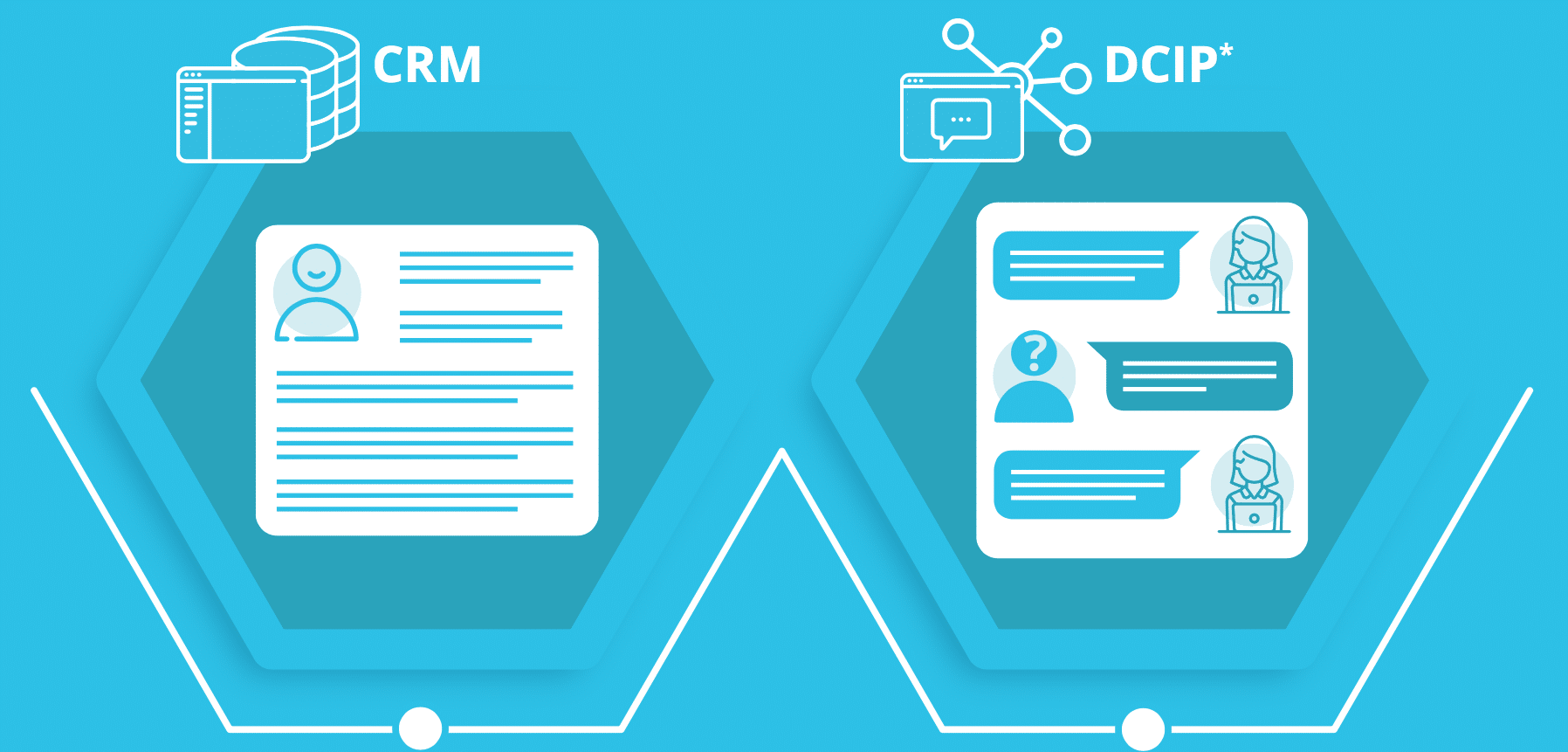Last month, we’ve started a new series about CRM and Digital Customer Interactions platforms. In our video, our international experts introduced both tools, the differences between them, and how their integration can benefit companies. For this second article, we are now giving you more details about the latter topic, along with an infographic.
1/ Get a 360° view of the customer
CRM and Digital Customer Interactions Platform collect different types of data, complementary to each other. On the one hand, a CRM software centralises all data available about a customer. It allows to know whether the user is a customer or not, and gathers all the associated data, such as his name, address, purchase history, lifetime value…
On the other hand, a Digital Customer Interactions Platform enables companies to process large volumes of messages on digital channels. By interacting with customers, it will be able to collect different types of data, such as their digital identities. Most importantly, it will be able to merge the different identities (Facebook, Twitter, e-mail…) of a single user.
Without integration, each tool keeps its own kind of data: the CRM gathers all the transactional data, but isn’t able to determine social identities and conversational content. The Digital Customer Interactions Platform collects conversational data from various sources but is not able to know if the user is a customer and its associated data.
The integration allows to tackle these limitations. By communicating together, both tools can enrich their data. Thanks to an identity matching, these platforms will benefit from each other :
– The CRM enriches the Digital Customer Interactions platform with data such as the name of the customer, his address, his purchase history, etc…
– The Digital Customer Interactions Platform feeds the CRM with data such as digital identities, conversation history, channel preference, etc…
Thanks to this process, companies will get a 360° view of their customers, gathering transactional and conversational data. This will be highly beneficial for departments using these tools, to make sure no information is lost. Any department interacting with customers (customer service, marketing, sales…) will access a full picture of customers.
2/ Manage everything in one place
After connecting these tools, it is essential to be able to view and manage the associated data from a single interface. If we focus on customer service for example, customer agents regularly need to access both tools separately. The Digital Customer Interactions Platform is used to answer messages, while CRM must be open in parallel to get information and enrich the customer profile. This means a higher handling time and more training required to make sure the agent knows how to use both tools.
With the integration, it is possible to group all these features through a unified interface. Thanks to APIs, companies can make data converge, and customize it to suit their needs. It is possible to choose which type of data will be visible in the interface: in the telecoms industry for example, it will be essential to access the end of the commitment period (stored in the CRM) when answering to enquiries.
The integration has several advantages for customer services. During an interaction, the agent can see the full customer profile within a single interface. By having more context, the agent is able to answer more efficiently and doesn’t have to ask the customer for information already known by the company. This contributes to the reduction of average handling time, meaning more satisfaction for the customer. If some information must be added to the CRM, it can be done more quickly too.
The integration will also benefit other departments such as sales and marketing. While they usually use data from CRM, the data coming from Digital Customer Interactions platform can help them communicate with more relevance with customers. For example, knowing their interests or digital identities will help marketing departments create more personalized emailing campaigns.
3/ Route messages more efficiently
As we’ve explained in our previous article, Digital Customer Interactions Platforms allow to route and prioritize messages. For companies dealing with thousands of messages each month, routing will be essential. It will allow to prioritize messages depending on their level of urgency and route them to the right agent, depending on the language or the enquiry topic.
A Digital Customer Interactions Platform uses its data to route messages. This can include its number of followers, its Klout score, the content and the language of the message… For example, a tweet sent by a user with 5 000 followers can be prioritized over another with 100 users. In the same way, a message written in Spanish can be automatically routed to a team of spanish speaking agents.
The routing can save much time to customer care departments, and can be refined thanks to the integration with a CRM. The CRM will bring more information about the customer, such as the date of his last purchase, his loyalty, his status (regular customer, VIP…). This data can be used by the Digital Customer Interactions Platform as routing criteria, making it more precise. For example, the status of a customer in the company can be used to prioritize his messages, instead of only taking into account his social influence.
As we have covered, integrating your CRM with your Digital Customer Interactions Platform will allow you to have a full view of your customers, gathering transactional and conversational data. This 360° view will be accessible from a single interface by any department needing it, helping them to better engage with customers. By routing messages more efficiently, helping agents to answer more efficiently and reduce their handling time, the integration will contribute to an improved customer service.
Discover the infographic:

Receive our upcoming CRM-related content in your inbox:
Originally published Nov 07, 2017, updated Dec 30, 2022





